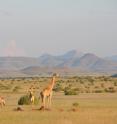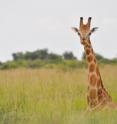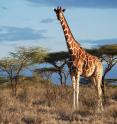Genetic analysis uncovers 4 species of giraffe, not just 1
Up until now, scientists had only recognized a single species of giraffe made up of several subspecies. But, according to the most inclusive genetic analysis of giraffe relationships to date, giraffes actually aren't one species, but four. For comparison, the genetic differences among giraffe species are at least as great as those between polar and brown bears. The unexpected findings reported in the Cell Press journal Current Biology on September 8 highlight the urgent need for further study of the four genetically isolated species and for greater conservation efforts for the world's tallest mammal, the researchers say.
"We were extremely surprised, because the morphological and coat pattern differences between giraffe are limited," says Axel Janke, a geneticist at the Senckenberg Biodiversity and Climate Research Centre and Goethe University in Germany. Giraffes are also assumed to have similar ecological requirements across their range, he added, "but no one really knows, because this megafauna has been largely overlooked by science."
Giraffes are in dramatic decline across their range in Africa. Their numbers have dropped substantially over the last three decades, from more than 150,000 individuals to fewer than 100,000. Despite that, the researchers say that there has been relatively little research done on giraffes in comparison to other large animals, such as elephants, rhinoceroses, gorillas, and lions.
About five years ago, Julian Fennessy of Giraffe Conservation Foundation in Namibia approached Janke to ask for help with genetic testing of the giraffe. Fennessy wanted to know how similar (or not) giraffes living in different parts of Africa were to each other, whether past translocations of giraffe individuals had inadvertently "mixed" different species or subspecies, and, if so, what should be done in future translocations of giraffes into parks or other protected areas.
In the new study, Janke and his research group examined the DNA evidence taken from skin biopsies of 190 giraffes collected by Fennessy and team all across Africa, including regions of civil unrest. The extensive sampling includes populations from all nine previously recognized giraffe subspecies.
The genetic analysis shows that there are four highly distinct groups of giraffe, which apparently do not mate with each other in the wild. As a result, they say, giraffes should be recognized as four distinct species. Those four species include (1) southern giraffe (Giraffa giraffa), (2) Masai giraffe (G. tippelskirchi), (3) reticulated giraffe (G. reticulata), and (4) northern giraffe (G. camelopardalis), which includes the Nubian giraffe (G. c. camelopardalis) as a distinct subspecies. The elusive Nubian giraffe from Ethiopia and the South Sudan region was the first described some 300 years ago, Fennessy says, and is now shown to be part of the northern giraffe.
The discovery has significant conservation implications, the researchers say, noting that the International Union for Conservation of Nature and Natural Resources (IUCN) Species Survival Commission Giraffe and Okapi Specialist Group recently submitted an updated proposed assessment of the giraffe on the IUCN Red List taking into consideration their rapid decline over the last 30 years.
"With now four distinct species, the conservation status of each of these can be better defined and in turn added to the IUCN Red List," Fennessy says. "Working collaboratively with African governments, the continued support of the Giraffe Conservation Foundation and partners can highlight the importance of each of these dwindling species, and hopefully kick start targeted conservation efforts and internal donor support for their increased protection.
"As an example," he adds, "northern giraffe number less than 4,750 individuals in the wild, and reticulated giraffe number less than 8,700 individuals--as distinct species, it makes them some of the most endangered large mammals in the world."
Janke and Fennessy say that they are now analyzing the amount of gene flow between the giraffe species in greater detail. In addition to expanding the ecological and species distribution data, they want to better understand the factors that limit gene flow and the giraffes' differentiation into four species and several subspecies.
Source: Cell Press
Articles on the same topic
- Giraffes more speciose than expectedThu, 8 Sep 2016, 19:06:21 UTC
Other sources
- Giraffe DNA study identifies four distinct speciesfrom BBC News: Science & NatureFri, 9 Sep 2016, 11:41:15 UTC
- Trilobites: A Quadruple Take on the Giraffe: There are Four Species, Not Onefrom NY Times ScienceFri, 9 Sep 2016, 6:11:15 UTC
- Giraffes more speciose than expectedfrom Biology News NetFri, 9 Sep 2016, 0:21:22 UTC
- All in the Family: Giraffes are 4 Species (Photos)from Live ScienceThu, 8 Sep 2016, 21:21:43 UTC
- 1 Long Neck, 4 Species: New Giraffe Diversity Revealedfrom Live ScienceThu, 8 Sep 2016, 21:21:42 UTC
- Tall tale: study reveals that giraffes are four species, not onefrom Reuters:ScienceThu, 8 Sep 2016, 20:41:18 UTC
- Tall tale: study reveals that giraffes are four distinct species, not onefrom CBC: Technology & ScienceThu, 8 Sep 2016, 19:51:35 UTC
- Genetic analysis uncovers four species of giraffe, not just onefrom Science DailyThu, 8 Sep 2016, 19:21:28 UTC
- Study: There are four giraffe species, not onefrom UPIThu, 8 Sep 2016, 19:01:24 UTC
- DNA reveals that giraffes are four species — not onefrom News @ NatureThu, 8 Sep 2016, 18:11:26 UTC
- Giraffe genetic secret: Four species of tallest mammal identifiedfrom BBC News: Science & NatureThu, 8 Sep 2016, 16:51:21 UTC
- Genetic analysis uncovers four species of giraffe, not just onefrom PhysorgThu, 8 Sep 2016, 16:01:35 UTC


